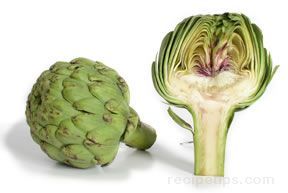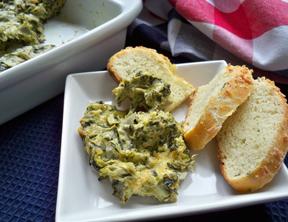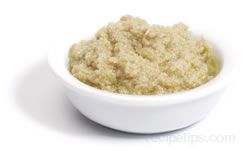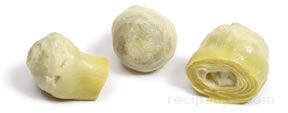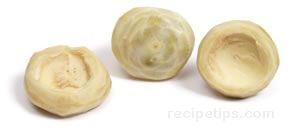The most common varieties of Artichokes found in food stores include the Green Globe, the Lyon, the Fiesole, the Anzio, the Campania, and the Big Heart. Green Globe and Lyon Artichokes are large in size with green colored leaves that are closely held within the head of the Artichoke. They are heavy in weight and are good varieties to marinate, to stuff with ingredients, to bake, broil, or to steam cook. The Globe and Lyon are very mild tasting and meaty in texture. The Fiesole is a burgundy to purple colored Artichoke that is not so globe shaped but instead more oval or boxy. Native to the Florence region of Italy, the Fiesole is best prepared by sautéing, boiling or steam cooking it, providing a mildly nutty flavor when eaten. Another variety of purple or red Artichoke is the Anzio, also native to Italy. Most often this Artichoke is served as a stuffed or baked vegetable and is a common ingredient in Italian cooking. Another red variety is the Campania, which is brighter in red coloring than the Anzio or the purple Fiesole. This Artichoke, which is larger in size than other varieties, is best served stuffed, baked, broiled, or steam cooked. The Big Heart Artichoke is a hybrid seed that has been developed in California to provide a meatier textured vegetable with thicker leaves and a larger heart. Green in color, the Big Heart has a shape that is more oval or square shaped than the Globe or Lyon. It is a variety that can be served much like other Artichokes, providing a mild but full Artichoke flavor.
To prepare the artichoke for cooking, wash the bud thoroughly. Chop off the stem attached to the base to remove some of the hard fibers surrounding the base. To keep the exposed base from turning brown, brush it lightly with vinegar or lemon juice. If the artichoke hearts are to be prepared, chop off the top third of the artichoke to remove the leaves and remove any remaining leaves from around the base. Remove and discard the fibers that make up the "choke" of the artichoke by scooping them out of the bud with a spoon or melon baller. The small round heart is now ready to be prepared in water mixed with a small amount of lemon juice or vinegar, cooking it for 5 to 10 minutes.

